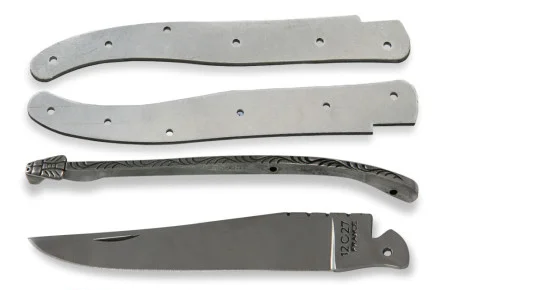

Menu
Menu


The Club collects information from all amateurs of knife-makingIf you want to speak about something important for you, don't hesitate contact us.
.png)

Cutting consists in cutting steel bars to a desired length. This operation only takes place if the blade is going to be forged.
Forging is the shaping of the metal into a blade by hot forging (professional knife blade) or cold forging (mono-bloc, scissors). This is followed by blanking and ironing processes which, using a power hammer, make the blade absolutely even and straight.
Stock removal is stamping a rough blade out of sheet iron using a press.
Heat treatments give steel blades the required hardness. The blade undergoes two sets of thermal variations.
Tempering: heating the metal to upper critical temperatures and rapid dousing harden it while also making it brittle. Quenching aims at accentuating the mechanical properties of steel. It thus:
- on one hand, increases its resistance to wear and its hardness,
- and on the other hand, lessens its resilience (tensile strength) and its resistance to shock. That is why various tempering processes exist: cold or ordinary, medium-hot, hot, martensitic, Austempering or other, depending on the steel or the desired result.
Quenching: more moderate and slower heating and cooling down process which gives back to the blade some of its suppleness so that it can be worked. This homogenises the structure of the steel and stabilises its mechanical proprieties. In general, it tempers the effects of the quenching and the fragility it causes by creating internal tensions. It effectively diminishes hardness and resistance to wear and increases resilience and malleability.
Profiling the blade: giving the blade its distinctive taper according to the chosen type of knife.
The blade is then dressed by hammer or with special machines. This process corrects any distortion caused during heat treatment and is only done on certain professional standard articles.
Grinding is an all important step, done with the help of special machines, rectifying both flanks of the blade. To grind a blade is to give it the taper (edge bevels) which decides how it will cut once sharpened. This mechanical process is nowadays mainly done using machines equipped with man-made grind-stones or sanding-belts that remove metal from the flanks of the blade to bring it very nearly to its finishing thickness. The process requires that the craftsman be extremely attentive: the speed at which the grind-stone turns as well as the pressure exerted can considerably change the quality of the cutting edge, causing faults you could call grind burns, spots where the metal overheated generating micro-cracks disastrous for the cutting precision of the blade.
Serration: notching a blade to create a serrated or micro-serrated edge. It can be carried out on one or both of the faces (for razor-sharpness).
Polishing and emery-finishing: these finer and finer grain abrasives and buffers enable the craftsman to obtain the desired finish of either mat, satin or mirror polish. We generally use special polishing tools. We can also when necessary do this operation by tribo-finishing.
Sharpening hones the blade's cutting edge.
Washing and degreasing require alkaline solutions or solvents.
Wiping the knife clean with cloth ensures perfect presentation.
Marking can be done by stamping the blade before quenching it, or by electrolysis, serigraphy, flash welding or laser.
This step generally takes place after grinding the blade. It entails assembling parts of pocket knives or fixing to the blade's tang handle parts that have been stamped and pressed (metal handles), injected or machine worked (plastics) or carved (wood, horn or ivory).
According to the type of knife and the raw material used, we mount the handle by:
- riveting, which is often replaced by clipping into place;
- over-molding;
- glueing;
- welding, sometimes with ultrasound.
check_circle
check_circle